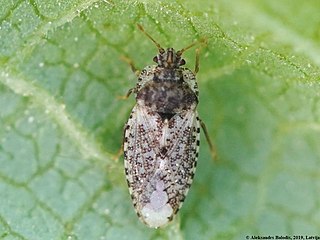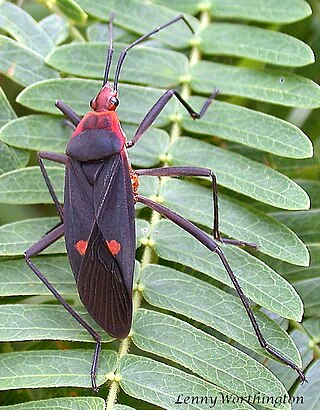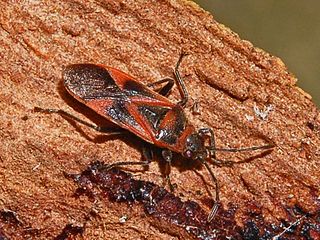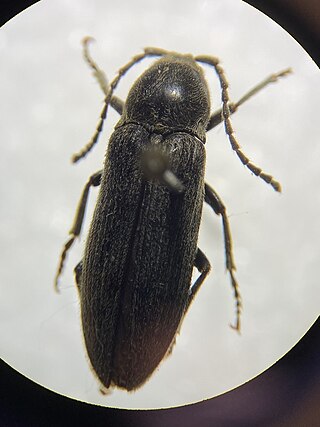
A barracuda is a large, predatory, ray-finned fish known for its fearsome appearance and ferocious behaviour. The barracuda is a saltwater fish of the genus Sphyraena, the only genus in the family Sphyraenidae, which was named by Constantine Samuel Rafinesque in 1815. It is found in tropical and subtropical oceans worldwide ranging from the eastern border of the Atlantic Ocean to the Red Sea, on its western border the Caribbean Sea, and in tropical areas of the Pacific Ocean. Barracudas reside near the top of the water and near coral reefs and sea grasses. Barracudas are targeted by sport-fishing enthusiasts.

The Rhyparochromidae are a large family of true bugs. Many species under Rhyparochromidae are commonly referred to as seed bugs, as are other species within the wider Pentatomomorpha. The family includes two subfamilies, more than 420 genera, and over 2,100 described species.

Piesmatidae is a small family of true bugs, commonly called ash-grey leaf bugs. The Piesmatidae are distributed mostly in the temperate Northern Hemisphere, with some occurring in Africa, Australia and South America. A common species found throughout the Americas is Piesma cinereum.

Lethocerus americanus, sometimes called the electric light bug, toe biter or fish killer, is a giant water bug in the family Belostomatidae, native to southern Canada and the United States. It typically has a length around 5–6 cm (2.0–2.4 in). It was originally classified as a species in genus Belostoma.

Apterostigma is a genus of New World ants of the subfamily Myrmicinae. Two species have been described from fossils preserved in Dominican amber, while the others are extant. They are fungus-growing ants, though, unlike the majority of other species in Attini who grow Lepiotaceae, some species have begun cultivating Tricholomataceae.

Cebrionini is a tribe of click beetles from the family Elateridae; formerly ranked as a subfamily or family, they are now considered a tribe within the subfamily Elaterinae.

Oregonia bifurca, commonly known as the split-nose crab or the split-nose decorator crab, is a species of crabs belonging to the family Oregoniidae. It is a rare deep-water species that inhabits the tops of seamounts and guyots in the northeastern Pacific Ocean; from the Aleutian Islands, the Bering Sea, the Hawaiian–Emperor seamount chain, to the waters off British Columbia. It is closely related to the more common shallow-water species Oregonia gracilis, the graceful decorator crab.

The Blissidae are a family in the Hemiptera, comprising nearly 50 genera and 400 species. The group has often been treated as a subfamily of the Lygaeidae but was resurrected as a full family by Thomas Henry (1997).

Melamphaus is an Old World genus of true bugs in the family Pyrrhocoridae, mostly found in Asia. They are often confused with bugs in the family Lygaeidae, but can be distinguished by the lack of ocelli on the head.

Zoosphaerium neptunus, also known as the giant emerald pill millipede, is a species of millipede within the family Arthrosphaeridae. Its size is an example of island gigantism, it being the largest known pill-millipede in the world, with some individuals reaching a maximum length of 90 mm long. The species is endemic to Madagascar, where it is known to swarm at certain times of the year. Z. neptunus is the only known species within the order Sphaerotheriida that is known to exhibit this mass swarming behaviour.

Oedancala dorsalis is an insect, found in the superfamily Lygaeoidea which is one of the largest varied family of Heteroptera of Hemiptera. Seed bugs are a very diverse family of seed feeders found on various types of vegetation. There are four Nearctic species in this genus. O. bimaculate and O. cubana are neotropical species that barely make it into the United States.

Arocatus is a genus of bugs in the family Lygaeidae.

Arocatus melanocephalus, the elm seed bug, is a Heteroptera in the family Lygaeidae. The species was initially described by Johan Christian Fabricius in 1798, and Maximilian Spinola designated it to be the type species of the genus Arocatus in 1837. This bug is native to Europe but has been introduced to North America.

Orsillinae is a subfamily of seed bugs in the family Lygaeidae. There are at least 110 described species in Orsillinae; the type genus is Orsillus.

Epuraea is a genus of sap-feeding beetles in the family Nitidulidae, first described in 1843 by Wilhelm Ferdinand Erichson. There are at least 40 described species in Epuraea. Their most notable food source is sap but these beetles also feed on organic matter such as fruits, flowers, fungi, decaying plant tissue, and the tissue of dead animals. Some species occur in bumblebee nests. Epuraea beetles commonly overwinter underneath logs or in soil.

Oncopeltus is a genus of seed bugs in the family Lygaeidae, which has at least 40 described species.

Armadillidium atticum is a European species of woodlouse endemic to Greece. It is a relatively small species and belongs to the so called "Armadillidium insulanum complex".
Orestes botot is a species of stick insects native in Vietnam.

Crompus opacus is a species of seed bug in the family Lygaeidae. It is a terrestrial insect found only in Australia. Crompus opacus is not currently listed under the Territory Parks and Wildlife Conservation Act 1976 in the Northern Territory of Australia.

Perothops is a genus of false click beetles in the family Eucnemidae containing 3 species. They are known as beech-tree beetles or perothopid beetles. They are small as they are only 10–18 millimeters long. It is the only genus in the monotypic subfamily Perothopinae. They are dark-colored beetles that are found across the United States, generally in forests. The genus was discovered by Johann Friedrich von Eschscholtz in 1836. It used to be considered a family not part of Eucnemidae. The genus's name is from Greek, translating to "maimed/crippled eye" or "eye of little necklaces/bands", referring to the placement of perothopid eyes.





















